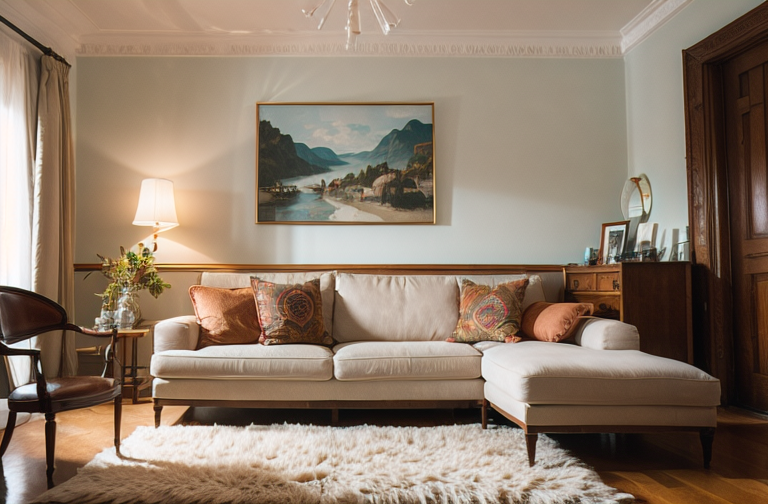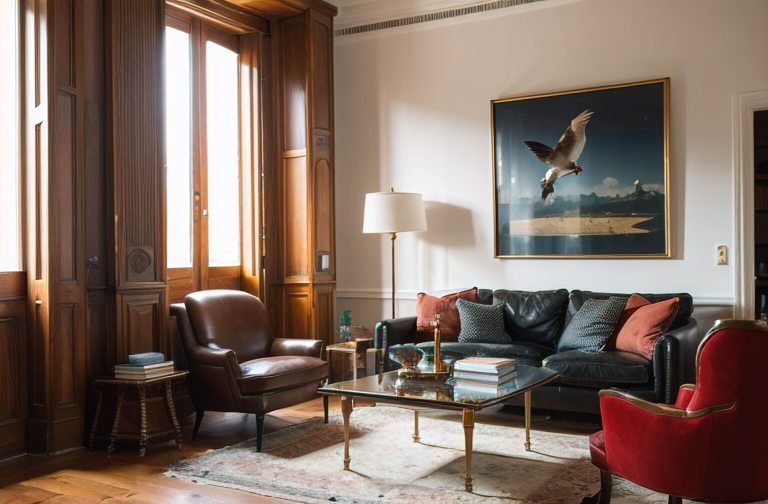Expanding Your Space: Tips and Tricks to Make a Small House Feel Larger

This article provides strategies for maximizing space in small houses, suggesting light shades, multipurpose furniture, clever home hacks and efficient lighting to enhance the perception of space.
Maximizing Space in Small Homes
Bountiful space is not a luxury afforded in all homes. As someone who has spent a considerable amount of time conceptualizing small house interior designs, understanding the craft and deploying strategic design tools to extract maximum value from compact spaces has become second nature.
The Importance of Clear Surfaces
Neat and clear surfaces, I believe, form the backbone of an effective design story in smaller spaces. How so, you may ask? The advantages are twofold. Firstly, having a judiciously decluttered space augments the overall aesthetic appeal. Secondly, it is a practical necessity. Keeping tabletops, counters immaculate, makes room for functionality. The idea is to understand the role every corner plays and utilize it suitably, without overcrowding.
The Role of Multipurpose and Space-Saving Furniture
What truly stands out in my design narratives are convertible furnishings. It is quite remarkable how a tiny, space saving piece of furniture can pack such a punch. Picture this a plush couch that transforms into a cozy bed for guests or perhaps, a storage equipped chair that accommodates your precious trinkets. Pieces like these aid in conserving space and bring in a distinctive flavor to the overall design.
Advantages of Wall-Mounted Furniture and Pocket Doors
Furniture adhering to walls and pocket doors work wonders in creating an impression of spaciousness. I have often recommended homes with space constraints to adopt wall mounted furniture pieces. Why? Because they truly help in freeing up floor space, giving your home a bigger and brighter look. Pocket doors too, slide nonchalantly, offering you the luxury of space without the bulky intrusion of regular doors.
As we delve deeper into our design journey, remember that even the most compact spaces can be transformed into stunning abodes with strategic design and an imaginative spirit. After all, the true beauty of design lies in the harmony of form and function.

Lighting and Shade Choices to Enhance Space
The realm of small and tiny house interior design ideas offers exciting opportunities for creativity, and there’s great potential hidden in our lighting and shade choices.
The Effect of Light Shades
Experimenting with my own living spaces, I’ve noted the curious melody light shades dance to, their transformative powers subtle yet profound. There’s a certain allure to choosing lighter shades: they invite openness into otherwise cramped spaces, creating a charming, more inviting ambience.
Role of Natural and Artificial Lighting
But those lighter shades only prove a partial tune, the symphony remains incomplete without the artistry of lighting. Natural and artificial illumination work in perfect harmony to amplify the perception of space. Having analyzed countless interiors, I can confidently place my bet on the role of natural light: it bestows upon small spaces an airy vitality, stimulating a grandeur that’s deceptive yet delightful. In the evening, well placed artificial lighting breathes life.
Incorporation of Mirrors for an Illusion of a Larger Space
Our spatial perception possesses a certain psychology — an understanding that’s intriguing to unpack. To draw the curtain over my third insight, I delve into the play of mirrors. Honestly, their inclusion is almost magical, rendering an illusion of a larger space. Doubling as extravagant decor elements, mirrors magnify the luxurious vibe with their reflective charm.
In the current burst of small and tiny house interior design ideas, understanding the roles of light shades, lighting, and mirrors increases the possibilities. So, the next time you craft a sanctuary in limited square footage, remember to play the tune of light and shade.
Smart Furniture Choices for Small Spaces
The art of maximizing space lies in the judicious selection of functional furniture pieces. In the context of a rustic interior design for small house, the choice becomes even more critical.
Multipurpose Furniture
True to its namesake, multipurpose furniture opens up a world of possibilities. From a classic sleeper sofa doubling up as a guest bed to a coffee table with hidden storage, these creative pieces ensure every inch counts. It isn’t merely about their utility value. They are the silent sculptures, engaging in an artistic dance with your living space, adding that touch of aesthetic appeal while serving a defined purpose.
Space-Saving Furniture
Space saving furniture, an ally in my quest for all things compact and chic, plays a pivotal role in planned space conservation. Consider beautifully designed wall mounted shelves or a built in dining table that seamlessly blends into your rustic decor. These ’hidden’ elements intricately woven into the design layout can dramatically enhance your livable space without cramping your style.
Using Corners Effectively
Corners, quite often, are overlooked and underutilized. A cozy corner desk or a creative ’corner bookshelf’ not only makes use of this often forgotten space but imparts a charming, rustic vibe to your small home. As I always say, there’s an enchanted quality to these corners—a sense of mystery that enriches the stories our living spaces narrate.
The art of space maximization in a small space goes beyond just functional furniture, it is about breathing life into the latent charms of your home, transcending the boundaries of space one piece of furniture at a time.

Effective Decor Themes for Small Homes
Minimalist motifs and the Japandi design trend can foster an expansive sense of space in tight quarters, with house of funk interior design pioneering the concept in recent years. The beauty lies in the absence, where lesser objects and elements create room for simplicity and thoughtfulness hallmark characteristics of a minimalist interior. This design aesthetic sparks an illusion of largeness within a small home, magnifying the perceived spaciousness. As for the Japandi design, the blend of Japanese minimalism and Scandinavian functionality is a masterstroke for small interiors. This east meets north fusion radiates warmth and serenity, lending a wonderful sense of openness to limited spaces.
Minimalist Motifs
The power of minimalist motifs lies in their ability to enlarge the small spaces. Keeping the clutter at bay and sticking to functional items allows for the room to breathe. Basic geometric shapes, neutral colors, and elegant, fuss free furniture are key elements. Remember, each item is a chance to make a statement — pick them wisely.
The Japandi Design
The utilization of the Japandi design in small homes is a standout approach. It melds Japanese ’zen’ elements with Scandinavian practicality. Clean lines, natural materials, and a muted color palette speak volumes about sophistication. The design trend focuses on functionality, thus using up space effectively.
Compact Entrances
Entrances of small homes can also encapsulate stylishness. Compact doesn’t necessarily mean missing out on style. Opt for sleek furniture pieces, wall hangers and mirrored surfaces for an impactful first impression. These elements not only serve practical purposes, but also set the visual tone right from your doorstep.
Creating beautiful and comfortable living spaces within small homes is no longer a daunting task with these effective décor themes. From minimalist motifs to compact entrances, every corner presents an opportunity to manifest aesthetic brilliance. As a passionate interior designer, I assure you, small can indeed be stylish and inspiring.
Key Takeaways
Emphasizing Space Maximization
Lending my understanding of design psychology, allow me to emphasize the importance of space maximization in small house interior designs. The art of increasing perceived space does not simply entail decluttering; instead, it involves advanced techniques like floor to ceiling visuals that direct the line of sight upwards. In essence, the art of space optimization transforms small and tiny house interior design ideas into functional, open, and expansive living spaces.
Harnessing Light and Shade
Novel yet crucial, the intricate dance between light and shade plays a significant role in shaping the ambience of a room. Remember that mirrors, aside from being lovely décor, serve a crucial role in enhancing the perception of space by reflecting light. Illuminate dark corners with strategically placed lamps to bring warmth and depth to your space.
Smart Furniture and Decor Choices
Finally, the potency of smart furniture and decor choices should never be overlooked. Substitute bulky furniture pieces with versatile and compact alternatives that serve multiple purposes—thus eliminating clutter and freeing up space—leading to a versatile, practical, and aesthetic abode.
As we journey through the realm of rustic interior design for small house, remember that your small haven could and should reflect a harmonious fusion of form and function. At the heart of design lies the ability to create beautiful, efficient spaces. The house of funk interior design vibes you can insert in your space should serve as a testament to the timeless truth that good things, indeed, come in small packages.
- Unlocking the Intricacies of Interior Design: Ranch-Style Homes and the Pursuit of Functionality
- Blending Tradition and Modernity: Exploring the Design of Nipa Hut and Trynagoal Tea House
- Enhancing Dining Experiences through Creative Interior Design and Rebranding in Burger Restaurants
- Mastering Home Renovation: The Crucial Roles of an Interior Designer and Effective Budget Management
- Understanding the Value of Interior Designers: Roles, Benefits, and Selection Process
- Exploring the Richness of Turkish Architecture and Interior Design through Adobe Stock and Pinterest
- Unveiling the Unique Characteristics and Design Elements of Ranch-Style Houses
- Embracing Openness and Personal Touch: The California Ranch House Interior Design Concept
- Embracing Warm Minimalism: The Rise of Brown Tones in Interior Design
- Enhancing Your New Home: Key Elements and Strategies in Interior Design
- Unveiling the Art of Luxury Interior Design: Exploration of Materials, Individual Style and Inspiration from Pinterest
- 13 Easy and Affordable Tips to Spruce Up Your Home Decor
- Exploring the Rich History and Distinctive Features of Tudor Architecture
- Exploring British Home Interiors: From Historical Evolution to Modern Adaptation
- Traversing the World of Interior Design: From Designer Profiles to DIY Ideas and Future-ready Furniture
- Contemporary Home Refinement: Leveraging Exposed Brick Design and Affordable, High-Quality Furnishings
- Exploring the Warmth and Charm of Modern Rustic Interior Design
- Enhancing Duplex and Triplex Interiors: An In-Depth Guide to Style, Lighting, and Effective Use of Space
- Creating Your Dream Bathroom: A Comprehensive Guide to Designs, Functionality, and Material Selection
- Creating Your Personal Spa: Insights into Modern Bathroom Design Trends



